-
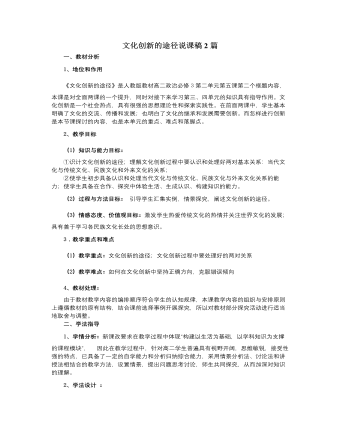
人教版高中政治必修3文化创新的途径说课稿2篇
PPT:文化创新的途径环节二:(展示情境 探究问题)情境一:先后展示徐悲鸿的《奔马图》和《愚公移山》设计意图:在作品的选择上遵循由易到难,由感性到理性的原则让同学们从中体会作者的创作情怀,比较两幅图表达的心境不同之处及其原因。探究一:从创作背景的不同,探究文化创新的根本途径。PPT:(设问)1、为什么同一画家在不同时期,作品所反映的内容不同?2、从中我们可看出,文化创新的根本途径是什么?设计意图:引导学生分析时代的变化对人们的社会实践的影响,因而文化工作者在体验生活的过程中创作的作品意境也会不同,培养学生透过现象看本质的能力,得出文化创新的根本途径是社会实践。教师过渡:在社会实践中,徐悲鸿先生还有什么创作的成功秘诀吗?探究二:从创作心得的展示,探究文化创新的重要途径(PPT)徐悲鸿一生致力于国画的创新实践,他认为革新中国绘画的要旨在于:“古法之佳者,守之;不佳者,改之;垂绝者,继之;未足者,增之;西方画之可采入者,融之。” 设计意图:通过阅读材料,培养学生寻找关键词的能力,并从中总结归纳文化创新的重要途径----继承传统、推陈出新。
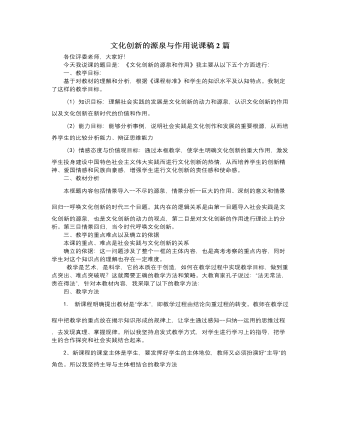
人教版高中政治必修3文化创新的源泉与作用说课稿2篇
一、教学目标:基于对教材的理解和分析,根据《课程标准》和学生的知识水平及认知特点。我制定了这样的教学目标。(1)知识目标:理解社会实践的发展是文化创新的动力和源泉,认识文化创新的作用以及文化创新在新时代的价值和作用。(2)能力目标:能够分析事例,说明社会实践是文化创作和发展的重要根源,从而培养学生的比较分析能力、辩证思维能力(3)情感态度与价值观目标:通过本框教学,使学生明确文化创新的重大作用,激发学生投身建设中国特色社会主义伟大实践而进行文化创新的热情,从而培养学生的创新精神、爱国情感和民族自豪感,增强学生进行文化创新的责任感和使命感。二、教材分析本框题内容包括情景导入--不尽的源泉,情景分析--巨大的作用、深刻的意义和情景回归--呼唤文化创新的时代三个目题。其内在的逻辑关系是由第一目题导入社会实践是文化创新的源泉,也是文化创新的动力的观点,第二目是对文化创新的作用进行理论上的分析。第三目情景回归,当今时代呼唤文化创新。
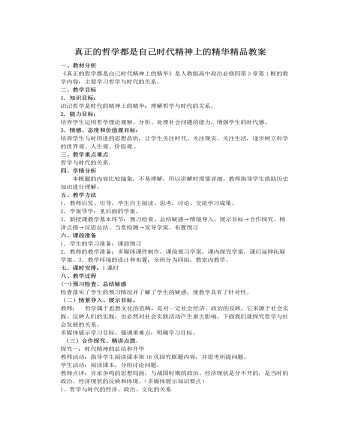
人教版高中政治必修4真正的哲学都是自己时代精神上的精华精品教案
一、教材分析 《真正的哲学都是自己时代精神上的精华》是人教版高中政治必修四第3章第1框的教学内容,主要学习哲学与时代的关系。二、教学目标1.知识目标:识记哲学是时代的精神上的精华;理解哲学与时代的关系。2.能力目标:培养学生运用哲学理论观察、分析、处理社会问题的能力,增强学生的时代感。3.情感、态度和价值观目标:培养学生与时俱进的思想品质,让学生关注时代、关注现实、关注生活,逐步树立科学的世界观、人生观、价值观 。三、教学重点难点哲学与时代的关系。四、学情分析本框题的内容比较抽象,不易理解,所以讲解时需要详细。教师指导学生借助历史知识进行理解。五、教学方法1.教师启发、引导,学生自主阅读、思考,讨论、交流学习成果。2.学案导学:见后面的学案。3.新授课教学基本环节:预习检查、总结疑惑→情境导入、展示目标→合作探究、精讲点拨→反思总结、当堂检测→发导学案、布置预习
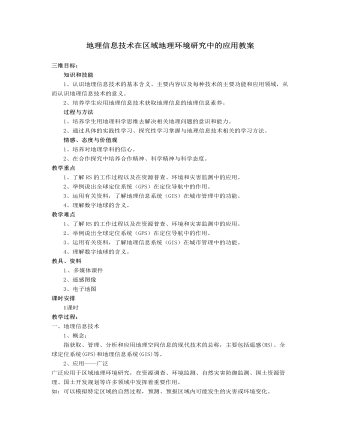
人教版高中地理必修3地理信息技术在区域地理环境研究中的应用教案
1.从监测的范围、速度,人力和财力的投入等方面看,遥感具有哪些特点?点拨:范围更广、速度更快、需要人力更少 、财力投入少。2.有人说:遥感是人的视力的延伸。你同意这种看法吗?点拨:同意。可以从遥感的定义分析。从某种意义上说,人们“看”的过程就是在遥感,眼睛相当于传感器。课堂小结:遥感技术是国土整治和区域发展研究中应用较广的技术 手段之一,我国在这个领域已经走在了世界的前列。我国的大部分土地已经获得了大比例尺的航空影像资料,成功发射了回收式国土资源卫星,自行研制发射了“风云”卫星。遥感技术为我国自然资源开发与利用提供 了大量的有用的资料,在我国农业估产、灾害监测 、矿产勘察、土地利用、环境管理与城乡规划中起到了非常重要的作用。板书设计§1.2地理信息技术在区域地理环境研究中的应用
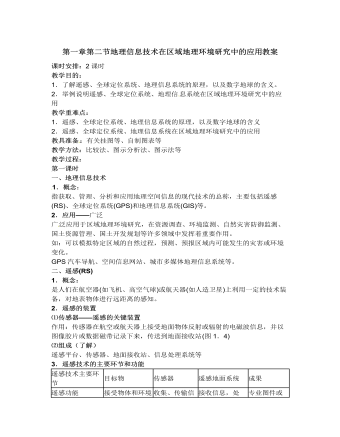
人教版高中地理必修3第一章第二节地理信息技术在区域地理环境研究中的应用教案
(4)假如你是110指挥中心的调度员,描述在接到报警电话到指挥警车前往出事地点的工作程序。点拨:接警→确认出事地点的位置→(在显示各巡警车的地理信息系统中)了解其周围巡警车的位置→分析确定最近(或能最快到达)的巡警车→通知该巡警车。(5)由此例推想,地理信息技术还可以应用于城市管理的哪些部门中?点拨:城市交通组织和管理、商业组织和管理、城市规划、卫生救护、物流等部门,都可利用地理信息技术。【课堂小结】现代地理学中,3S技术学科的发展与应用,日益成为地理学前沿科学研究的重要领域,并成为地理学服务于社会生产的主要途径,现在3S技术已经广泛应用于社会的各个领域。它们三者既有分工又有联系。遥感技术主要用于地理信息数据的获取,全球定位系统主要用于地理信息的空间定位,地理信息系统主要用来对地理信息数据的管理、更新、分析等。
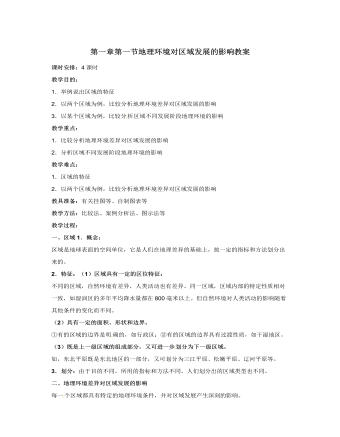
人教版高中地理必修3第一章第一节地理环境对区域发展的影响教案
教学重点:1.比较分析地理环境差异对区域发展的影响2.分析区域不同发展阶段地理环境的影响教学难点:1.区域的特征2.以两个区域为例,比较分析地理环境差异对区域发展的影响教具准备:有关挂图等、自制图表等教学方法:比较法、案例分析法、图示法等教学过程:一、区域1.概念:区域是地球表面的空间单位,它是人们在地理差异的基础上,按一定的指标和方法划分出来的。2.特征:(1)区域具有一定的区位特征:不同的区域,自然环境有差异,人类活动也有差异。同一区域,区域内部的特定性质相对一致,如湿润区的多年平均降水量都在800毫米以上。但自然环境对人类活动的影响随着其他条件的变化而不同。(2)具有一定的面积、形状和边界。①有的区域的边界是明 确的,如行政区;②有的区域的边界具有过渡性质,如干湿地区。

人教版高中历史必修2罗斯福新政说课稿2篇
1、教材的地位作用本课是新人教版普通高中历史必修Ⅱ第六单元第18课的内容,阐述罗斯福新政的背景、措施、影响。从单元知识安排看,本课与第17课《空前严重的资本主义世界经济危机》、19课《战后资本主义的新变化》共同诠释第六单元课题——《资本主义世界经济政策的调整》。说明了“资本主义经济理论和政策随着资本主义发展而不断调整的特点”,凸显了“市场调节”和“国家干预”在经济发展中的重要性。从知识体系看,它是学生学习了第一次工业革命后自由资本主义、第二次工业革命后的垄断资本主义等之后出现的,既是对上述知识的巩固与综合运用,又为学生学习必修二的相关内容打下基础,有承上启下的作用。本课三个子目从逻辑上看又是递进关系。第一个子目“临危受命”承上启下,说明了罗斯福上台的历史背景具有临危受命的特点,第二个子目“实施新政”讲述了罗斯福新政的主要内容,第三个子目“摆托危机困境”主要讲述了罗斯福新政的影响。
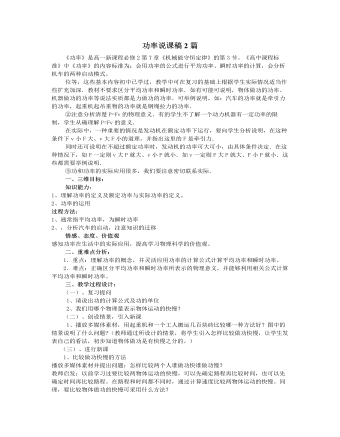
人教版新课标高中物理必修2功率说课稿2篇
(一)、复习提问1、请说出功的计算公式及功的单位2、我们用哪个物理量表示物体运动的快慢?(二)、创设情景,引入新课1、播放多媒体素材,用起重机和一个工人搬运几百块砖比较哪一种方法好?图中的情景说明了什么问题?(教师通过所设计的情景,将学生引入怎样比较做功快慢,让学生发表自己的看法,初步知道物体做功是有快慢之分的。)(三)、进行新课1、比较做功快慢的方法播放多媒体素材并提出问题:怎样比较两个人谁做功快谁做功慢?教师启发:以前学习过要比较两物体运动的快慢,可以先确定路程再比较时间,也可以先确定时间再比较路程。在路程和时间都不同时,通过计算速度比较两物体运动的快慢。同理,要比较物体做功的快慢可采用什么方法?
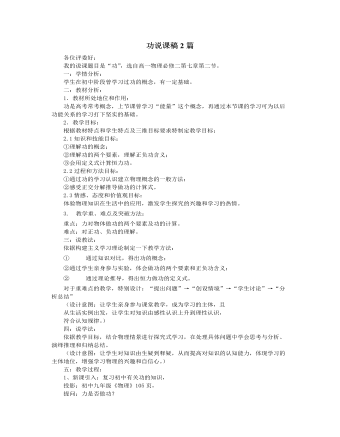
人教版新课标高中物理必修2功说课稿2篇
探究一:高中阶段功的含义是什么?投影:初中九年级《物理》105页学生思考:①图中物体的势能、动能分别如何变化?②物体能量的变化和做功是否存在关系?学生:分组讨论,得出结论:如果物体的能量发生变化时,说明有力对物体做了功。教师:进行点评和小结(设计意图:对初中知识深化理论认识,并为以后功能关系的教学作准备)探究二:力对物体做功的两个要素是什么?情景再现:找体重相对悬殊的两位同学,①A同学试图抱起B同学,但没成功。②B同学抱起A同学在教室内匀速走动。学生思考:在①中,A是否对B做功?在②中,B是否对A做功?学生:分析得出做功的两要素:物体受到力的作用,并且在力的方向上发生位移.教师:让学生分别例举生活中力对物体做功和不做功的例子,(设计意图:让学生亲身参与课堂实验,烘托课堂气氛,相互协作增进同学情谊)探究三:如果物体的位移不再力的方向上,那么力是否还对物体做功?
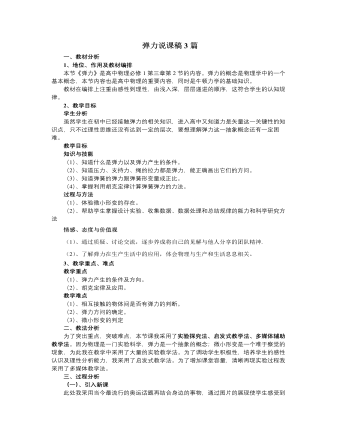
人教版新课标高中物理必修1弹力说课稿3篇
基于以上分析,为使本堂课围绕重点、突破难点,同时让学生在课堂教学中能力得到提高,我设计如下教学过程。(一)创设情景认识形变由同学们已有的形变知识入手,引入新课。教师演示:①弹簧的压缩形变;②弹簧的拉伸形变③视频播放:竹竿形变、钢丝的扭转形变。得出形变的概念及各类形变。[设计意图:我从生活情景中引入新课,是为了激发学生的好奇心,为学生学习重点和难点内容作铺垫。]设问:摩天大楼在风的吹拂下会不会摆动,发生形变吗?演示微小形变放大实验:由于这种形变不容易观察,会使学生产生疑问:到底有没有发生形变?解决的办法是微小形变的演示实验。为什么光点会往下移?让学生带着问题思考后得出结论:是由于桌面发生了形变,但是形变不明显。为后面解决压力和支持力都是弹力做好铺垫。[设计意图:使学生知道“放大”是一种科学探究的方法。]

新人教版高中英语必修3Unit 1 Festivals and Celebrations教学设计二
1. Ss look at the picture and scan the passage to understand the main idea while teacher is giving the following questions to inspire Ss to think.*Where are those people?*What are they doing?*Why are they so excited?2. Ss complete the passage with the appropriate -ing form. Then discuss and check the answers with class.Answers: boring, interesting, taking, exciting, amazing3. The teacher raises questions for the students to discuss and encourages them to express their opinions.*Do you like La Tomatina? Why or why not?4. Each group representative reports the discussion result, the teacher gives feedback and the evaluation.Step 6 PracticeActivity 41. Ss complete the Ex 2 in Using structures.2. Check the answers after finishing the exercises.①The dragon boat races are the most exciting part of the Dragon Boat Festival.② The children were excited to go Easter egg hunting.③What an amazing performance! This is the best music festival I have ever been to.④We were amazed by her funny-looking hat.⑤His inspiring speech at the conference won the admiration/ favour of the audience.⑥This is a challenging game to test your memory and observation capabilities. 3. T asks Ss to finish Ex 3 and 4 in Using structures by themselves, then check the answers with class.Step 6 Homework1. Understand and master the functions and usage of the -ing form;2. Finish the other exercises in Using structures.1、通过本节内容学习,学生是否理解和掌握动词-ing形式作定语和表语的功能和意义;2、通过本节内容学习,学生能否在理解文段内容的基础上,根据上下文语境和表达逻辑,能正确运用动词-ing形式描述节日庆典。3、通过本节内容学习,学生是否归纳和积累用于表达情绪的相关词汇。

新人教版高中英语必修3Unit 1 Festivals and Celebrations教学设计一
本板块的活动主题是“谈论节日活动”(Talk about festival activities),主要是从贴近学生日常生活的角度来切入“节日”主题。学生会听到发生在三个国家不同节日场景下的简短对话,对话中的人们正在参与或将要亲历不同的庆祝活动。随着全球化的进程加速,国际交流日益频繁,无论是国人走出国门还是外国友人访问中国,都已成为司空见惯的事情。因此,该板块所选取的三个典型节日场景都是属于跨文化交际语境,不仅每组对话中的人物来自不同的文化背景,对话者的身份和关系也不尽相同。1. Master the new words related to holiday: the lantern, Carnival, costume, dress(sb)up, march, congratulation, congratulate, riddle, ceremony, samba, make - up, after all. 2. To understand the origin of major world festivals and the activities held to celebrate them and the significance of these activities;3. Improve listening comprehension and oral expression of the topic by listening and talking about traditional festivals around the world;4. Improve my understanding of the topic by watching pictures and videos about different traditional festivals around the world;5. Review the common assimilation phenomenon in English phonetics, can distinguish the assimilated phonemes in the natural language flow, and consciously use the assimilation skill in oral expression. Importance:1. Guide students to pay attention to the attitude of the speaker in the process of listening, and identify the relationship between the characters;2. Inspire students to use topic words to describe the festival activities based on their background knowledge. Difficulties:In the process of listening to the correct understanding of the speaker's attitude, accurately identify the relationship between the characters.

新人教版高中英语必修3Unit 1 Festivals and Celebrations教学设计三
*wide range of origins(= a great number of different origins, many kinds of origins)*It featured a parade and a great feast with music, dancing, and sports. (=A parade and a great feast with music, dancing, and sports were included as important parts of the Egyptian harvest festival.)*.. some traditions may fade away and others may be established.(= Some traditions may disappear gradually, while other new traditions may come into being.)Step 6 Practice(1) Listen and follow the tape.The teacher may remind the students to pay attention to the meaning and usage of the black words in the context, so as to prepare for the completion of the blanks in activity 5 and vocabulary exercises in the exercise book.(2) Students complete the text of activity 5 by themselves.The teacher needs to remind the students to fill in the blanks with the correct form of the vocabulary they have learned in the text.Students exchange their answers with their partners, and then teachers and students check their answers.(3)Finish the Ex in Activity 5 of students’ book.Step 7 Homework1. Read the text again, in-depth understanding of the text;2. Discuss the origin of festivals, the historical changes of related customs, the influence of commercial society on festivals and the connotation and essential meaning of festivals.3. Complete relevant exercises in the guide plan.1、通过本节内容学习,学生是否理解和掌握阅读文本中的新词汇的意义与用法;2、通过本节内容学习,学生能否结合文本特点快速而准确地找到主题句;3、通过本节内容学习,学生能否理清论说文的语篇结构和文本逻辑,了解节日风俗发展与变迁,感悟节日的内涵与意义。

人教版高中英语必修1Journey Down the Mekong说课稿
2. let the Ss complete the forms paragraph by paragraph. Purpose here is to help Ss to get the habit of reading a passage as a whole, and pay attention to the organization of the text, as a result the Ss will fully understand the whole passage.3. ask Ss to retell the passage with the help of the key words in the form.Since the Ss in the class are in different levels, so I let them to fill in the blank to understand the meaning of the words and phrases better. ( That’s all for the while-reading. Now let’s move to the fifth step.)Step V: Post-reading (10mins) ---DiscussionIn this part students are asked to discuss in groups and list Wang Kun’s and Wang Wei’s attitudes about the trip. After that, Ss are encouraged to express their attitudes with the whole class. Collect their answers and don’t forget to praise them even if their answers may not be perfect.In this activity, discussion provides a vivid and active learning environment for Ss to communicate in English with newly learned language items. (Finally it comes to the homework.)StepⅥ: Homework (1min)1. Ss are required to read the text again after class and figure out the meaning of some complex sentences.2. Do the exercises on P19; This can help Ss to consolidate what they’ve learnt and make preparation for the next lessonPart4. Blackboard design.(说板书设计)On the top, there is the title of this lesson. On the left, there are main ideas for each paragraph. On the right, there are some new words and expressions.Unit 3 Travel journalJourney down the MekongMain idea of each para.:Para1: deciding to take a great bike trip along the Mekong river.Para2: Different attitudes between Wang kun and Wang wei.

人教版高中英语必修1Anne's best friend说课稿
Step 7 Language points 1.Vocabulary (1) go through (2) set down (3) a series of (4) on purpose (5) in order to (6)at dusk (7)entirely (8)face to face 2.Important sentences (1)…I’ve grown so crazy about everything to do with nature. (2)There was a time when … (3)I stayed awake on purpose until … (4)It was the first time … that I’d seen the night … (5)It’s no pleasure looking through … Purpose: 1.Master the required vocabulary and sentence structures. 2.Use them freely. Step 8 Consolidation 1.Find out the topic sentences 2.Retell the text according to the topic sentences Purpose: I want to know if my students understand the text. Step 9 Discussion Imagine you have to go into hiding like Anne and her family, what would you miss most? Giveyour reasons. Purpose: Train Ss’ oral English ability. Step 10 Homework Write an article on Friends. Purpose: 1. Improve the Ss’ writing ability. 2 Train the Ss’ ability of self—teaching and looking up information by themselves. Part 5 Blackboard design(说板书设计)Unit 1 Friendship Reading Anne’s Best Friend 1.Main idea of each paragraph: Para. 1 Anne made her diary her best friend. Para .2 Anne wrote her feelings in her diary. Para .3 Anne missed nature. Para.4 Anne saw the night face to face Para.5 Anne wanted to experience nature outdoors. 2.Listening: Exx.1 P3 3.Discussion: Exx.3 P3 Purpose: 1.Make Ss familiar with the passage 2.Make the design inductive, instructive and artistic.

人教版高中英语必修1Nelson Mandela--A Modern Hero说课稿
In this step, give students a few minutes to read the passage . While they are reading, I will write some key words of the text on the blackboard. Then ask students to retell the passage according to the key words.By retelling, students can improve their ability of language organization and have an overall understanding of the article.Step 4 Group discussionIn this step, students will be divided into groups of 4 to discussion the following question: What qualities make a great person?After their discussion, invite a few groups to make a report to the class.This group discussion can practice students’ oral English and cultivate their abilities of cooperation and communication.Step 5. HomeworkLet students write a short passage to introduce a great person he or she admires.The homework can consolidate the knowledge the students have learned and cultivate their writing ability. Part 6 Blackboard Design(板书设计)That’s all my teaching procedures. Finally, I’d like to say sth about part 6 blackboard design. On the top is the title. On the left, there will be some new words and expressions. In the middle of the blackboard, I will write some useful sentence structures so that the students can know clearly what they’ve learned and then try to master the knowledge.OK. That’s all for my presentation. Thank you for your attention.

人教版高中英语必修1English around the world说课稿
(3)v. 给:提出;展现,显现present sb. with sth. ; present sth. to sb. 把. . 交给;颁发;授予present sth. (for sth. )/present sth. to sb. e. g. Om his birthday, his friends presented him a collection of stamps. 在他生日时,他的朋友们送给他一套邮票作为礼物。The sword was presented by the family to the museum. 这家人把宝剑捐赠给了博物馆。The committee will present the final report to Parliament in June. 委员会将在六月向议会提交最后的报告。You need to present yourself better. 你需要更善于展现自己。It is essential that we present a united front. 至关重要的是我们要表现得更加团结。Step 4 ConsolidationT:Now that we have got a general idea of these words and phrases. Lets make up some sentences using them to master them. Suggested sentences:1. Your duties include typing letters and answering the telephone. 2. It is one of the greatest roles that she has played. 3. A large number of people have applied for the job. 4. The number of the panda is declining. 5. I'11 go there, even if I have to walk. 6. He came up to me to ask for a light. 7. The novel is about a family who can't communicate with each other. 8. He based his plan on interests of most people. 9. Why doesn't he make use of his singing talent?Step 5 Summary and homeworkT:Today we dealt with several new words and phrases. After class I hope that youcan read them again and again to keep them in mind. That's all for today. You aredismissed.

新人教版高中英语必修3Unit 2 Morals and Virtues教学设计二
Activity 41. Students complete the task of activity 4, then teachers and students check the answers. 2. The teacher organized the students to work together and asked them to use the tables and mind maps sorted out before to retold the important choices in Lin Qiaozhi's life and their resultsStep 5 Language points1. The teacher asks the students to read the text carefully, find out the core words and long and difficult sentences in the text and draw lines, understand the use of vocabulary, and analyze the structure of long and difficult sentences. 2. The teacher explains and summarizes the usage of core vocabulary and asks the students to take notes. 3. The teacher analyzes and explains the long and difficult sentences that the students don't understand, so that the students can understand them better. Step 6 Homework1. Read the text again, in-depth understanding of the text; 2. Master the use of core vocabulary and understand the long and difficult sentences. 3. Complete relevant exercises in the guide plan. 1、通过本节内容学习,学生是否理解和掌握阅读文本中的新词汇的意义与用法;2、通过本节内容学习,学生能否结合文本特点总结林巧稚的人生原则和人格品质特征;3、通过本节内容学习,学生能否针对人生抉择发表自己的看法;能否全面地、客观地、理性地看待问题,进而对道德和人性有更加深入的思考和理解。

新人教版高中英语必修3Unit 2 Morals and Virtues教学设计三
The joke set her crying.这个玩笑使她哭起来。Step 5 ReadingActivity 31. Students read the small text in activity 3. The teacher provides several small questions to check whether students understand the content of the text and the ideographic function of the -ing form in the text.*Where are those people?*Why did Dr Bethune come to China?*How did he help the Chinese people during the war?*What did Chairman Mao Zedong say about him?2. Ss try to rewrite some sentences using the -ing form. Then check the answers. When checking the answers, the teacher can ask different students to read the rewritten sentences and give comments.Answers:1. he became very interested in medicine, deciding to become a doctor.2. …after hearing that many people were dying in the war.3. Helping to organise hospitals, he taught doctors and nurses, and showed people how to give first aid./ He helped to organise hospitals, teaching doctors and nurses, and showing people how to give first aid.4. …praising Dr Bethune as a hero to be remembered in China.Step 6 PracticeActivity 4Students complete grammar activities 2 and 3 on page 69 of the workbook.Step 6 Homework1. Understand and master the functions and usage of the -ing form;2. Finish the other exercises in Using structures.1、通过本节内容学习,学生是否理解和掌握动词-ing形式作宾语补足语语和状语语的功能和意义;2、通过本节内容学习,学生能否正确使用动词-ing形式描述人物的行为、动作及其经历;3、通过本节内容学习,学生能否独立完成练习册和导学案中的相关练习。

新人教版高中英语必修3Unit 2 Morals and Virtues教学设计四
3.Teachers ask different groups to report the answers to the questions and ask them to try different sentence patterns.The teacher added some sentence patterns for students to refer to when writing.Step 4 Writing taskActivity 51.Write the first draft.Students first review the evaluation criteria in activity 5, and then independently complete the draft according to the outline of activity 4, the answers to the questions listed in the group discussion and report, and the reference sentence pattern.2.Change partners.The teacher guides the students to evaluate their partner's composition according to the checklist of activity 5 and proposes Suggestions for modification.3.Finalize the draft.Based on the peer evaluation, students revise their own compositions and determine the final draft.Finally, through group recommendation, the teacher selects excellent compositions for projection display or reading aloud in class, and gives comments and Suggestions.Step 5 Showing writingActivity 5T call some Ss to share their writing.Step 6 Homework1. Read the passage in this section to better understand the passage.2. Carefully understand the hierarchical structure of the article, and deeply understand the plot of the story according to the causes, process and results;3. Independently complete the relevant exercises in the guide plan.1、通过本节内容学习,学生是否理解和掌握阅读文本中的新词汇的意义与用法;2、通过本节内容学习,学生能否通过人物言行的对比分析道德故事的深层内涵;3、通过本节内容学习,学生能否根据故事的起因、经过和结果来深入理解故事的情节,从而了解文章的层次结构;4、结合现实生活案例发表自己的见解和看法,写一篇观点明确、层次分明的故事评论。